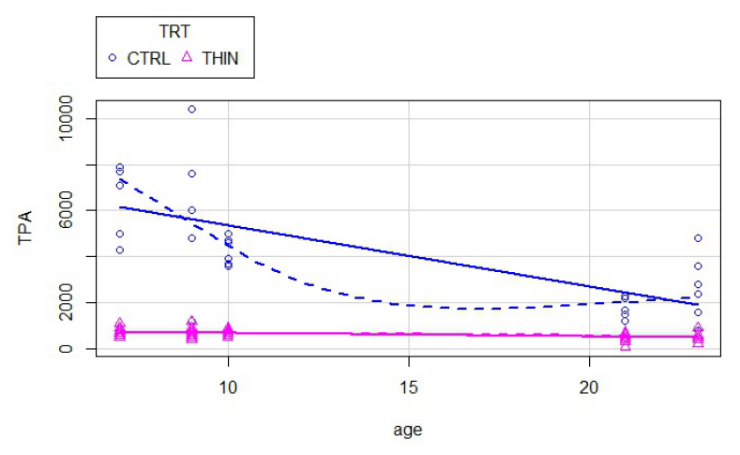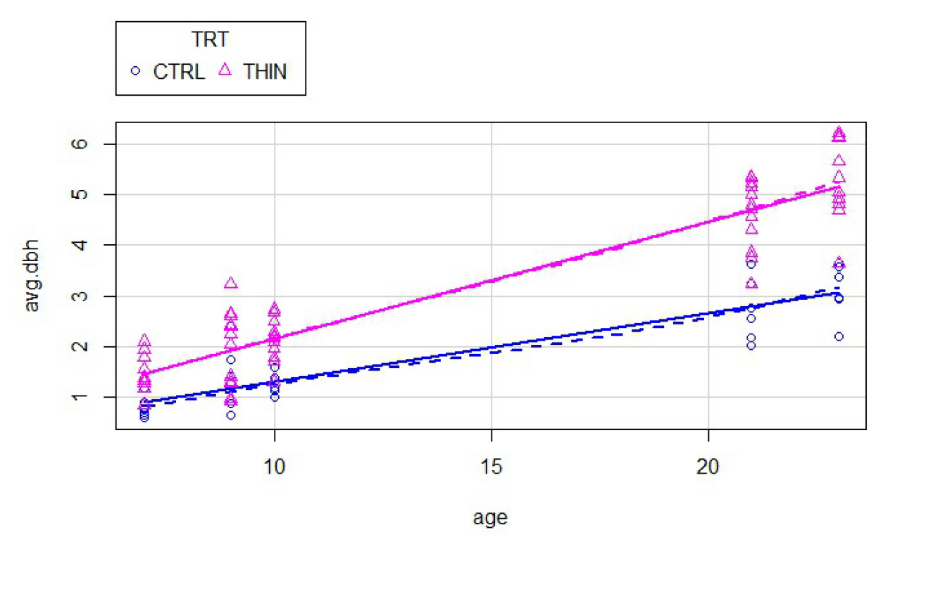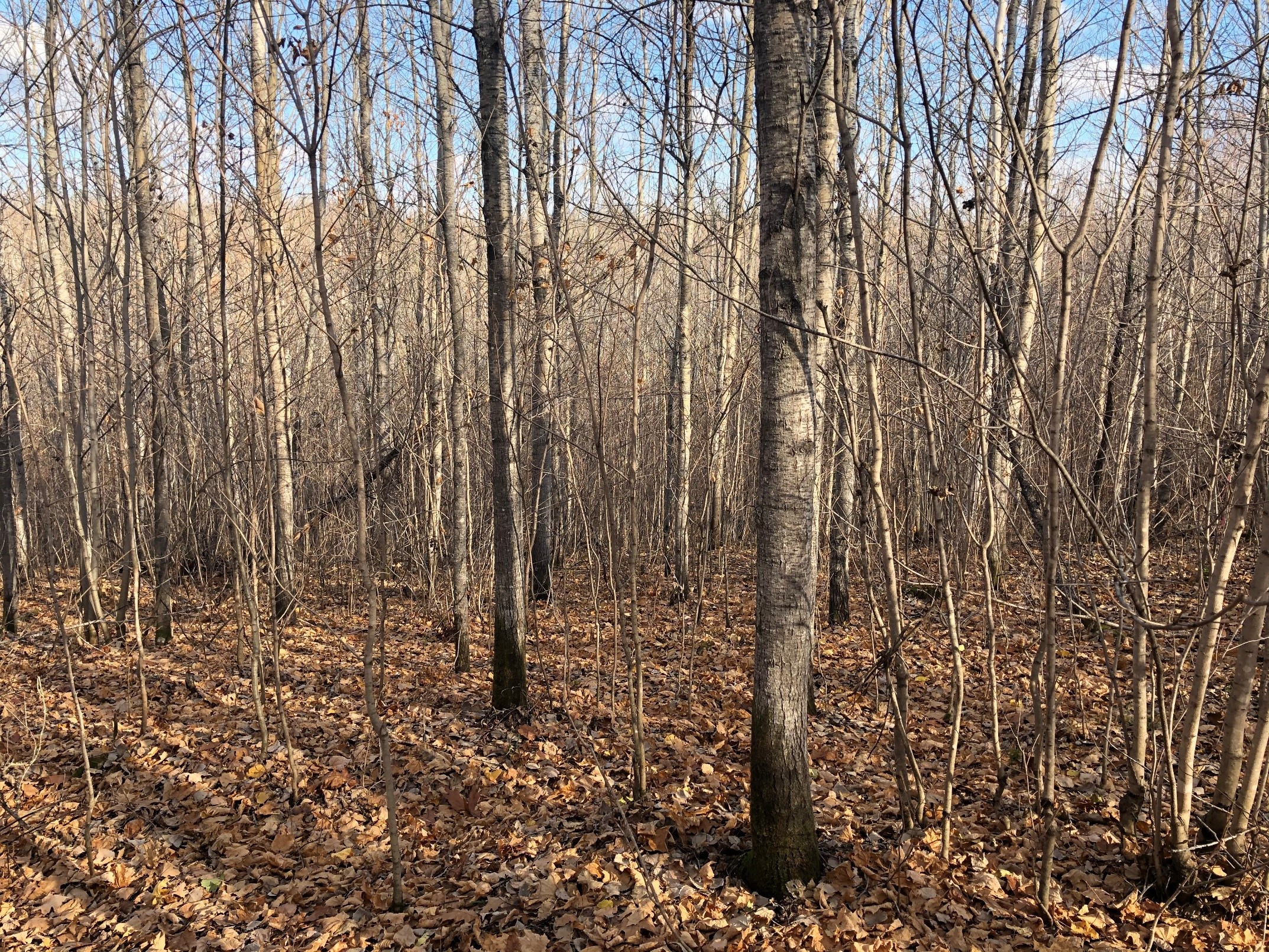Overview
The goal of this case study was to evaluate the effectiveness of pre-commercial thinning in an even aged aspen as a tool to decrease rotation ages and hasten the production of merchantable timber. We are reporting results 16 years after the treatment was implemented.
The use of pre-commercial thinning as a silvicultural treatment at relatively early ages of stand development can promote higher productivity and shorter rotations within aspen stands. High quality sites where aspen growth is known to be exceptional were chosen based on NPC and local forester knowledge. Rich Mesic Hardwood Communities were targeted (MHn35 and MHn47) were targeted for treatment.
In this case study, using a pre-commercial thinning treatment on high-quality sites enhanced growth of quaking aspen, allowing the stands to produce larger DBH compared to untinned stands. Anecdotally these early stand treatments may benefit wildlife by increasing sunlight to the forest floor at a time when intense competition for light generally begins to reduce woody browse and forage abundance from the herbaceous layer.
Silviculture Objective(s)
The main objective of these precommercial thinnings is to reduce rotation ages in even-aged aspen stands and to assess whether the achieved responses justify the silvicultural expense.
Pre-treatment stand description and condition
Stand establishment and management history:
All three study sites were established following clearcut harvests of 50-70 year old aspen stands. All harvests occurred between 1995 and 1997. Each of the three stands were successfully regenerated with pre-treatment (thinning) density of 4000 - 8000 stems per acre at age seven.
Pre-treatment species composition:
Quaking aspen (Populus tremuloides), paper birch (Betula papyrifera), red oak (Quercus rubra), red maple (Acer rubrum), and sugar maple (Acer saccharum)
Pre-treatment growth and stocking:
Regeneration densities ranged from 4,000 to 8,000 stems per acre at age 7 when the study was initiated. Stocking was heavily dominated by aspen.
Landowner objectives/situation:
UPM Blandin owns and manages timberlands across north-central Minnesota and also operates a light-weight coated paper mill in Grand Rapids, Minnesota. UPM Blandin lands are actively managed to produce fiber for the Blandin mill, as well as dozens of other regional markets across the region. Aspen is utilized in the Blandin mill, and is the most in-demand species within the regional forest industry. Having access to silvicultural tools which can both enhance production of these systems and strategically manage rotations and age classes is an important tool.
Silviculture Prescription
Pre-commercial thinning via mechanical brush saws was applied in each of the three stands in order to reduce the density and focus growth on the best individuals. Prior to thinning, stem densities ranged from 4000-8000 TPA. Thinning crews were instructed to thin the stands, selecting the best individuals, and targeting a density of 700-900 TPA. Each of the stands had 10-25% of the stand area left untreated as an unthinned control so that quantitative comparisons could be made.
What actually happened during the treatment
Using hand-held brush saws, thinning crews reduced stand density from 4000-8000 TPA to 700-900 TPA (725 average) at stand age seven. Crop trees were selected based on species, spacing, vigor, and best phenotypic quality. The reserved crop trees were the largest and best-formed trees within the stand. Other hardwoods such as red oak were left throughout sites to facilitate species diversity.
Post-treatment assessment
Stands were evaluated at ages immediately following treatment at age 7, and then again in 2007, and again 2018. In total, the data collected allows for evaluation of thinning responses 16 years post-treatment.
The treatments very effectively reduce the density to the target levels (Figure 1). After 16 years, the unthinned control stands continue to retain densities 3-5 times higher than unthinned control units, indicating that the self-thinning processes is still ongoing in unthinned stands (Figure 1). This suggests that the benefits of the thinning may be relatively long-lived, with control stands still “catching up” to the accelerated stand development observed in the thinned units. Diameter (both QMD and DBH) responded to the reduction in density (Table 1). Sixteen years after treatment, when stand ages were 21-23, average DBH was approximately 70% larger in thinned stands compared to unthinned controls. See table below, and charts in the "photographs" section below for details.
Table 1: Summary of quadratic mean diameter (QMD), average diameter at breast height (DBH), and density trees/acre) for aspen stands treated with pre-commercial thinning.
STAND AGE | Treatment | QMD (inch) | avg. DBH (inch) | Trees/Acre |
7 | CTRL | 0.9 | 0.8 | 6616 |
7 | THIN | 1.5 | 1.5 | 725 |
9 | CTRL | 1.5 | 1.4 | 6266 |
9 | THIN | 2.1 | 2 | 716 |
10 | CTRL | 1.3 | 1.2 | 4250 |
10 | THIN | 2.2 | 2.1 | 675 |
21 | CTRL | 3 | 2.7 | 1766 |
21 | THIN | 4.8 | 4.6 | 516 |
23 | CTRL | 3.3 | 3.1 | 2667 |
23 | THIN | 4.4 | 5.2 | 500 |

Figure 1: Density of aspen regeneration following pre-commercial thinning (THIN) compared to unthinned control units (CTRL)

Figure 2: Average diameter of aspen regeneration following pre-commercial thinning (THIN) compared to unthinned control units (CTRL)

Figure 3: Unthinned control unit in 2019 when the stand was approximately 22 years old. Note the high density of stems and lack of larger "crop trees"

Figure 4: Thinned unit in 2019 when the stand was approximately 22 years old. Note the high density of stems and the larger "crop trees" of aspen present.
Plans for future treatments
No future treatments are planned for these units. Because the management objective is to shorten rotations, these stands will be monitored for merchantability. When stands achieve a desirable average diameter and/or volume (10+ inch DBH and/or 25 cords per acre), a final harvest will be initiated. If resources are available, further measurement may be done to further assess the impacts of these thinning treatments.
Costs and economic considerations
The pre-commercial thinning that is being implemented throughout these stands has a substantial up-front cost. Because of the high up-front cost, this thinning technique is only prescribed on nutrient rich sites were aspen growth is expected to be exceptional. Generally, site quality is assessed by using Native Plant Community Classification with MHn35 and MHn47 being preferred communities for this type of intensive aspen management. Financial returns on this type of thinning can only evaluated after the stand has gone through a full stand-level economic analysis including all costs and future returns. While modelling could be used to conduct such an analysis now, reliable growth and yield information for this type of treatment is not readily accessible. Beyond the stand level economic considerations, forest managers must consider the forest-wide implications and advantages of being able to shorten rotation ages, particularly for remedying imbalances in ownership wide age class distributions.
Other notes
This case study was developed with support from the United States Department of Agriculture's National Institute for Food and Agriculture, Renewable Resources Extension Act. Project #2021-46401-35956, principal investigator Eli Sagor, University of Minnesota.
Climate Adaptation Considerations
Climate change was not considered in the establishment of the case study. However, UPM Blandin has now identified these treatments as an important component of their climate adaptation strategy moving forward. Pre-commercial treatments in recent years have been altered slightly to put more emphasis on releasing climate adapted species such as red oak, white pine, basswood, and yellow birch. Additionally, these well-thinned stands are likely more resistant to drought and other stressors due to the greatly reduced competitive environment and increased stand vigor.
Summary / lessons learned / additional thoughts
This simple study suggests that pre-commercial thinning is a viable option to accelerate early stand growth with the potential for substantially decreased rotation length. The exact degree to which these treatments will decrease rotation ages is yet to be determined. Based on anecdotal evidence from stands which were treated with bulldozer strip thinning, a widely used pre-commercial thinning method employed in north-central Minnesota, it appears that rotation ages could be reduced by as much as 10 years.
This treatment was designed to mimic, but accelerate, the natural progression of thinning that takes place within a stand when competition from surrounding trees crowds the growing space. Stand development is stimulated early on, so the trees have a chance to grow without the limitations of an overcrowded, traditionally dense aspen stand.
Lastly, it is recognized that in these early treatments, there is an opportunity to encourage species diversification. In recent treatments there has been an effort to reserve and release high quality oaks, birch, and conifer through the thinning process. Blandin continues to implement aspen pre-commercial thinning on select sites both to enhance site productivity and to accelerate climate adaptation by diversifying species composition and increasing stand vigor.
Figure 4 Thinned unit in 2019 when the stand was approximately 22 years old. Note the high density of stems and the larger "crop trees" of aspen present.
